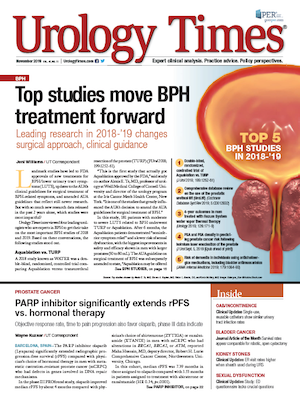Publication
Article
Urology Times Journal
Combination therapy addressed in amended OAB guideline
Author(s):
In this interview, Sandip Vasavada, MD, discusses the rationale behind the recent amendment to the AUA/SUFU guideline for overactive bladder, the role of OAB drugs in the treatment of nocturia, and treatment of refractory OAB.
Liudmila Dutko - stock.adobe.com

The AUA and Society of Urodynamics, Female Pelvic Medicine & Urogenital Reconstruction’s guideline for overactive bladder was recently amended to include updates regarding patient factors and treatment selection as well as second- and fourth-line treatments. In this interview, Sandip Vasavada, MD, a member of the guideline amendment panel, discusses the rationale behind the amendment, the role of overactive bladder drugs in the treatment of nocturia, and treatment of refractory OAB. (To read the amended guideline, see bit.ly/oabguideline.) Dr. Vasavada is urologic director, the Center for Female Urology and Reconstructive Pelvic Surgery at Cleveland Clinic. Dr. Vasavada was interviewed by Urology Times Editorial Consultant Gopal H. Badlani, MD, professor of urology, Wake Forest Baptist Medical Center, Winston-Salem, NC.
What prompted the recent amendment to the OAB guideline?
Every time new data comes out, we assess the current guideline to determine whether there is anything we need to add. In this case, the guideline update was done because there was new data regarding second-line therapies, predominantly medication use. Specifically, the data indicated that the use of an anticholinergic in conjunction with a beta-3 agonist is an option for patients who perhaps didn’t get significant relief with either beta-3 agonist or anticholinergic monotherapy.
Does the guideline address the inability to prescribe beta-3 agonists initially, especially in the elderly?
It doesn’t directly address that. There is an ongoing national dialogue on the use of anticholinergics in the elderly especially that concerns its potential adverse effects on cognition. While beta-3 agonists work on a different nerve receptor, the issue of initial prescription also has to do with pharmaceutical coverage, and that is a tougher area to address.
How do you sequence treatment in a drug-naive patient who presents with symptoms of OAB?
Just like any other patient we see with OAB, we still want to go through the pathway sequentially. I think we would all agree that proceeding from least invasive to most invasive therapy is still best. We did keep a little bit of flexibility within this current guideline, but the main point is still starting with behavioral therapies and fluid management as well as pelvic floor exercises and continuing that to the second- and third-line therapies if initial therapies do not work after an acceptable period of time. That’s one of the points we’d like to emphasize.
What is the role of OAB drugs in a patient with predominantly daytime symptoms with minimal nighttime frequency?
They still have a strong role. You don’t have to have a lot of nighttime symptoms to merit the need for overactive bladder drugs, although OAB seems to have a day and night tendency for many. Regardless, some patients seem to have predominantly daytime symptoms. Again, we’d want to determine whether there’s a behavioral factor or something else going on during the day that is creating their overactive bladder. Is there a transient cause or another factor that’s perhaps creating the disparity between day and night? We can target our interventions at some of the behavioral factors in addition to using medications. We wanted to also emphasize this in the guideline.
Do drugs help patients with predominantly sensation-driven frequency?
I think the data would suggest there are some slight improvements, but not as much as we like to believe. The sensory symptoms are oftentimes quite challenging; you’re looking at different scales. Most data is on urge incontinence and frequency as harder endpoints. Still, the hallmark of OAB is urgency, pathologic urgency specifically, and it is still probably best assessed using a variety of validated instruments.
Next: What is the role of OAB drugs in nocturia?What is the role of OAB drugs in nocturia?
In solitary nocturia, unless there’s another cause, as often there is-fluid overload and other background factors-it can still have a role but probably less. But you have to be very careful, as anticholinergics especially can have a fair amount of side effects. We have to be considerate of that in a nocturia patient, where there may be another cause, whether it’s fluid overload, obstructive sleep apnea, edema, or any number of other causes. I would do my best to try to treat all of those attending causes before proceeding with an anticholinergic or for that matter a beta-3 agonist.
How do you define refractory overactive bladder?
I don’t believe it’s ever been formally defined, but typically a patient with refractory overactive bladder is one who’s tried and failed first- and second-line therapy and/or is intolerant to second-line therapy. Those patients then go on to the so-called third-line therapies. Again, I don’t think it’s ever been truly defined in clinical guidelines.
There are a plethora of treatments for refractory overactive bladder: percutaneous tibial nerve stimulation, sacral neuromodulation, and onabotulinum toxin. How do you sequence these treatments? Do you use an algorithm?
I don’t know if it directly falls into an algorithm because every patient has unique factors that might dictate a reason why one would be more apt to undergo one therapy over another. You have to individualize each patient scenario. Less often, determining which therapy is best for a patient would come down to a “coin flip.”
There are data suggesting that patients who fail neuromodulation then switch to Botox, and vice versa. Is that your experience?
When we ran a randomized trial, it was hard to enroll patients for whom determination of treatment came down to a coin flip. Oftentimes, there’s a specific patient factor that will guide the clinician’s choice of treatment. If a patient has bowel issues, perhaps you may lean more toward neuromodulation. For a neurogenic patient, you might tailor your recommendations toward onabotulinumtoxinA injections. If a patient doesn’t need anything more invasive therapeutically and is willing to make frequent visits, then you may consider tibial nerve stimulation.
As we learn more about OAB, it becomes apparent that particularly in the elderly, there are so many different factors to look at before you start treating the patient. What suggestions do you have for evaluating management options in this population?
I’d see if there’s anything else more easily remediable. Is there another factor? Is it stress incontinence? Is it prolapse, which often co-exists for some of these patients? Is it vaginal atrophy, which can have an effect in some patients in terms of overactive bladder symptomatology? Is it a fluid factor? If you work with your primary care colleagues to articulate what the real issue is leftover for the overactive bladder alone, you can tailor your therapy most appropriately.
Is there anything else you feel urologists should know about the updated guideline?
One of the important things we brought out with this new guideline is that one does not necessarily need to progress stepwise in order: one, two, three, four. We did codify the fourth line, which includes augmentation cystoplasty, urinary diversion, and catheter placement. The patient shouldn’t just be stopped at third-line therapy. There are, in selective situations, opportunities to deliver care with any of these slightly more invasive therapies. Perhaps someone may be cognitively at risk for using a medication, so we might consider tibial nerve stimulation earlier in the treatment pathway. Based on the guideline and expert opinion, we felt that that’s an option we wanted to leave our providers with.
Comments? Email them to the editors at urology_times@mmhgroup.com




























